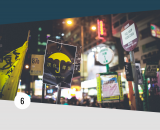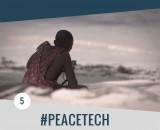Peace Needs a Sharp, Pointy Stick
(Legal disclaimer: The author of this article is an outsider with total respect and appreciation for the peacebuilding community but only limited knowledge of how it actually works, its protocols, and its best practices. But here goes…)
As a creative person who works in advertising, I sell things. Currently, those items include beer, running shoes, and frozen waffles—all critically important to human existence, but of course, not nearly as vital as peace.
The question is this: if peace were a product or service, how would we promote it? From a marketing perspective, peacebuilding faces three obstacles: a nebulous definition, the violence itself, and a crowded media ecosystem.
Those who experience violence and instability firsthand, truly appreciate what it means to have peace. The rest of the world is fortunate enough to see peace as something mundane, taking it for granted. Peace remains an ethereal concept for many outside the peacebuilding community.
Peacebuilding faces competition not only from ethnic hatred, greed, religious extremism, and nationalism, but also from our 24/7 media culture. More than ever, peace efforts must compete with viral videos, sports mania, Facebook feeds, and other entertainment content for a place at the table.
Peacebuilding vies for one of the most valuable commodities on earth: people’s attention. Peace needs a sharp pointy object to puncture the thick, leathery hide of distraction and human indifference.
That sharp object is creativity.
Think of creativity as a new idea or a new interpretation of an old idea. The “Like a Girl” campaign is one brilliant example of how creativity can redefine old social norms. The campaign flipped this common phrase on its head, igniting a conversation and building the confidence of girls and young women worldwide.
In peacebuilding, creativity has the power to change human behavior, inject renewed urgency into an old issue, resolve conflict, and save lives. Creativity is, of course, no substitute for the fieldwork so essential to conflict resolution—but it can amplify and complement these efforts. The mobile phone campaign, “We Are Peace Kenya,” for example, shifted a troubling trajectory of election violence in the country, creating peace by sending more than half a million text messages to citizens, encouraging positive behavior and unity.
“Nazis Against Nazis” was an ingenuous creative move by the small, German town of Wunsiedel that raised money for an anti-fascist group by turning the tables on an annual neo-Nazi march. Local residents and businesses sponsored each meter of the march, pledging a total of €10,000 to the anti-fascist effort and making the Hitler aficionados look (and feel) pretty silly in the process.
The irony of using an event against itself built awareness for the nonprofit—a German-based organization that works to rehabilitate extremists—and raised money to support their peacebuilding efforts. The action was indirect, but it succeeded in diffusing hate and making peace more tangible, while undermining the message of the extremist group. Could an idea like this be reworked to reduce the recruitment appeal of ISIS, for example?
Shock can also be used to raise awareness. While Cosmopolitan (Cosmo) magazine typically serves as a distraction from more pressing matters, British Cosmo took a bold swerve from its standard fare with its February 2015 issue. This limited edition was created for the non-profit Karma Nirvana, to promote awareness of honor killings.
The special edition featured the face of a woman appearing to be suffocated, symbolizing the true story of a 17-year-old British-Pakistani woman who was suffocated and killed by her parents for refusing an arranged marriage. The magazine was given to members of Parliament and generated twenty-eight million media impressions and nearly £5 million in earned media for the cause. It also led to the creation of a National Day of Remembrance for honor killing victims.
Social media can also invite active participation in a cause. The question is how to create value beyond a simple “like” or “follow.” An organization’s mission must be placed directly into people’s hands . . . or thumbs, as the Lebanese women’s organization KAFA did.
To urge Lebanese lawmakers to rule domestic violence a crime, KAFA invited the public to show its support by posting photos of their red thumb on social media with the line “Vote for us, we’ll vote for you.” More than two million people—half the Lebanese population—were exposed to the message. This simple galvanizing act generated twenty-two million Twitter impressions from fifteen countries, $1.7 million in free PR, and—most importantly—prodded Lebanese lawmakers to pass the requested bill.
“Red Thumb/Vote for us. We’ll vote for you.”; KAFA
These successes were tangible and easy enough to measure. In peacebuilding, success may be harder to evaluate. While the for-profit arena measures success metrics like brand awareness and sales growth constantly to ensure a return on investment, measuring the number of lives saved—deaths that do not happen—is more elusive.
In late 2015, this challenge became apparent at the Chicago launch of “Put the Guns Down,” a hip-hop movement inviting participants to add their rap verse to a song against gun violence. It garnered great PR coverage, healthy YouTube viewership, and dozens of submissions. Yet the city began 2016 with the most gun deaths since the late 1990s.
Does this mean the effort was ineffective? Would the world have been better off without it? Certainly not. It is unrealistic to think that even the most creative communication effort could instantly make the lure of the drug trade unattractive. The initiative made a positive impact on the community’s dialogue around gun violence and, today, it’s likely that a number of people are alive because someone heeded the message.
“Put the Guns Down”; Music Vs. Gun Violence
Deeply rooted problems that fester over time are especially challenging for mass communication efforts. But a well-crafted creative message—delivered at the right time to the right people—can make a difference. For communication professionals who lend their expertise to help reduce violence and oppression—but who work outside the peacebuilding field—sustaining their efforts over time is a challenge. But the same can be said for those within the field: it takes patience and persistence over time to make a meaningful difference.
Many global citizens are fortunate enough to be able to take peace for granted, making the process of selling peace one fraught with challenges. But the sharp, pointy stick of creativity can help redefine peace, renew its promise, and raise it as a priority in the minds of many. In short, creativity can help build something as important as peace itself: hope.
(Feature Photo Credit: Screen capture from “Nazis against Nazis – Germany’s most involuntary charity walk ” by Rechts gegen Rechts)

